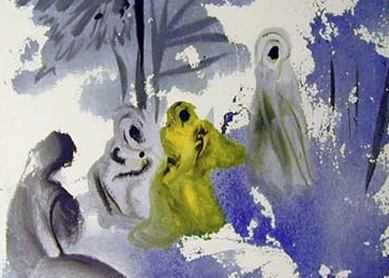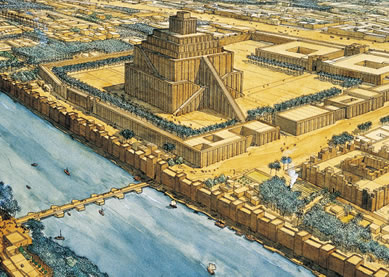Together with Solomon’s temple, the tower of Babel may be the best-known building in the Hebrew Bible. The notion of a tower reaching toward heaven is deeply inscribed in our cultural memory. As a result, readers often overlook the fact that Gen 11:1-9 reports little about the actual tower. For example, the story only implies that the workers stopped building the tower. The tower’s destruction, though often read into the story, is never stated. Instead of being the central interest of the story, the tower functions as a symbolic motif.
The people who built the tower of Babel were driven by fundamental human concerns. They preferred settlement to the uncertainties of dispersion, uniformity to diversity, fame and power to obscurity and weakness. But in the account in Gen 11:1-9, God denies their preferences. At the center of the story is humanity’s transition from speaking one language and living in one location to speaking several languages and living in multiple locations across the world.
What is God’s problem with the tower?
The standard answer is that the project of building a tower reaching the heavens is a symbol of humanity’s arrogant pursuit of fame and power—ideas closely linked in the ancient Near East. It is true that God expresses some concern about safeguarding the line between the human and divine spheres, perhaps even suggesting that the people pose some kind of threat to the divine realm (Gen 11:6, Job 42:2). The tower, then, is a symbol of humanity’s ability and propensity to cross boundaries and of God’s endeavor to check such behavior.
The tower itself, however, is a minor motif—something mentioned twice and only in passing (see Gen 11:4-5). The narrative’s conclusion focuses on the real issue at hand: God’s dissolution of humanity’s linguistic unity, an act that results in dispersion and that reflects the historical experience of the Israelites in the exilic and postexilic periods. The story ends with an etiology (an origin story) connecting the name of the city with the confusion (balal) of languages and identifying the city as the origin point for the dispersion of humanity (Gen 11:9).
How and when was the tower of Babel story written?
Scholars often assume that the story of the tower of Babel was stitched together from different sources or that it underwent stages of literary development. As evidence, they point to subtle tensions, apparent repetitions, and the seemingly large number of motifs. Since none of the individual elements are superfluous, however, such reconstructions are hardly convincing. Literary and historical analysis may suggest that a poem mocking Babel was the core tradition of the story.
The story of the tower of Babel concludes the biblical primeval narrative (Gen 1-11), whose origin is often explained by assuming a combination of two previously independent sources. Here, our story is generally attributed to the earlier source. But as the story meshes well with the genealogies of the second, later source, this argument is questionable. Additionally, the Babel story seems to have in view the stories about Abraham and Sarah, both of whom are from Mesopotamia (see Gen 11:31). All this would seem to suggest that Gen 11:1-9 was composed after the strands of the primeval history and the ancestral narrative were combined, which likely happened fairly late (sixth century B.C.E.). Even so, the age of a story whose author we do not know remains difficult to determine. Gen 11:1-9 is a myth set in primeval times, but this setting indicates neither that the text was written at the same time the “events” occurred nor that it is later.
Here, the tower can help us. Because the story mentions Babel and is also set in the land of Shinar (Gen 11:2), scholars argue that the text’s author was thinking of the ziggurat Etemenanki, which is located in ancient Babylon. The imagery of a building reaching the heavens supports this suggestion (Gen 11:4). If this is correct, then Gen 11:3 provides further evidence for the time of writing: the oldest ziggurat was originally built with mud bricks. Only at the latest building stage, in the seventh century B.C.E., did it receive a sheathing of fired bricks. It is also possible that the notion of an “unfinished” tower is connected with the extensive damage done by the Persian king Xerxes (518–465 B.C.E.) to religious buildings in Babylon. All things considered, the tower of Babel story is likely a postexilic addition to the primeval history.
Bibliography
- Gertz, Jan Christian. “The Formation of the Primeval History,” in The Book of Genesis: Composition, Reception, and Interpretation (ed. C. A. Evans, J. Lohr, and D. L. Petersen; Leiden: Brill, 2012), 107–36.
- LaCocque, André, The Captivity of Innocence: Babel and the Yahwist. Eugene, Ore.: Wipf & Stock, 2010.
- Schmid, Hansjörg. Der Tempelturm Etemenanki in Babylon. Mainz: von Zabern, 1995.
- Hiebert, Theodore. “The Tower of Babel and the Origins of the World’s Cultures.” Journal of Biblical Literature 126 (2007): 29–58.
- Uehlinger, Christoph. Weltreich und “eine Rede”: Eine Deutung der sogenannten Turmbauerzählung. Freiburg: Universitätsverlag; Göttingen: Vandenhoeck & Ruprecht, 1990.



